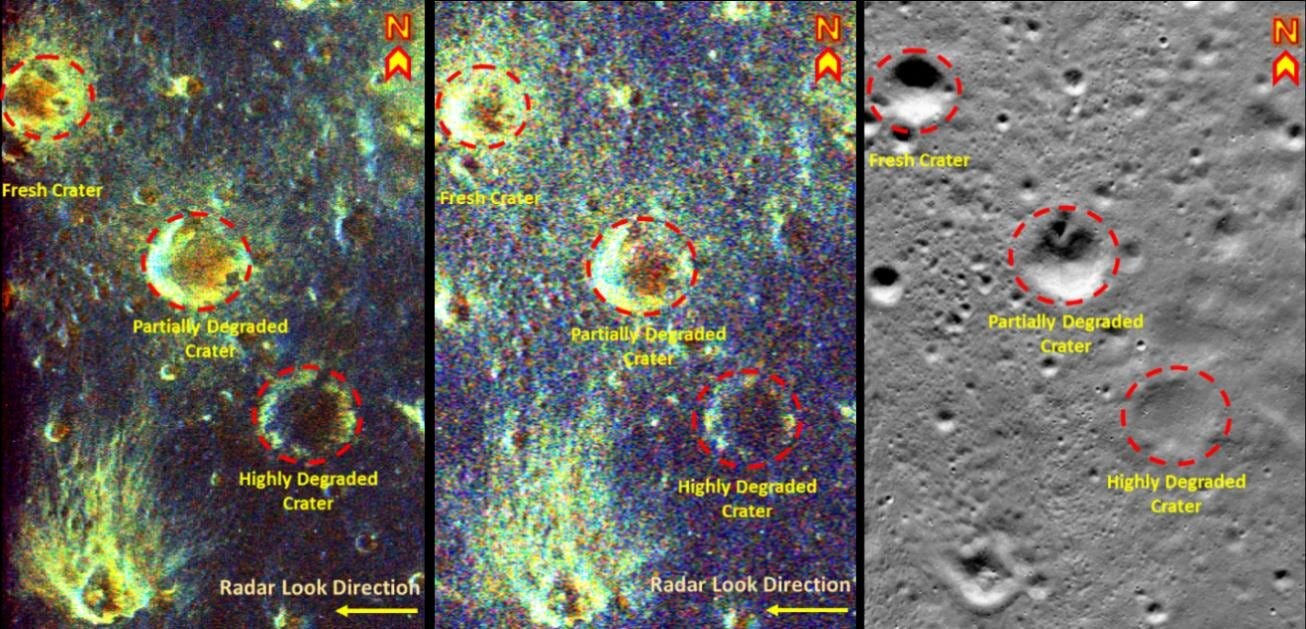Moon Monday Issue #7
ISRO releases Chandrayaan 2 orbiter data, NASA's 2021 Moon budget, finding too many Moon craters, and more developments in the lunar space.
Highlight
ISRO has released data from their Chandrayaan 2 lunar orbiter, after originally promising to do so in March and October 2020 respectively. The data release, which follows the standard Planetary Data System 4 format, comes after a series of in-flight calibrations. ISRO says, “The data received suggests excellent capability to deliver on the pre-launch promises”. I’ve written about some of those pre-launch promises here.

The initial dataset ranges from September 2019 to February 2020 from seven out of eight instruments (papers on each), and can be accessed at pradan.issdc.gov.in/pradan. The missing instrument is the infrared spectrometer, successor to the M3 on Chandrayaan 1 famous for discovering water on the Moon, which ISRO says will be added soon. If you haven’t registered on ISRO’s data portal before, note that it may take a few weeks before your application is processed.
Exploration
NASA’s budget for the fiscal year 2021 is out, which will see Congress provide nearly $23.3 billion to the agency. Key elements of NASA’s lunar exploration program viz. SLS, Orion, Gateway and related systems were funded in line with the agency’s requested amount. However, at $850 million, the Human Landing System was underfunded by about 4x, which will likely affect the currently targeted 2024 landing for Artemis III. The budget also provides $451 million for “Lunar Discovery and Exploration”, including $22 million to continue the Lunar Reconnaissance Orbiter and $70 million to continue targeting at least one robotic mission to the Moon’s surface per year under the CLPS program.
NASA and Boeing engineers successfully loaded about 2.6 million liters of cryogenic propellant in SLS’ core stage on December 20 as part of the seventh Green Run test of the rocket engines. But the test ended a few minutes before the planned countdown duration. NASA says the issue doesn’t appear to be hardware related. The team is analyzing the data to pinpoint the issue and accordingly decide if to move forward with the last Green Run test of hot firing all four engines of the rocket’s core stage.
As part of NASA’s Tipping Point contract to Blue Origin worth $3 million, both entities successfully tested their co-developed autonomous, precision navigation software with a live simulation of a spacecraft landing at the Moon’s south pole, following a successful test with similar hardware on Blue Origin’s New Shepard rocket flight on Earth in October 2020. The tests demonstrated the system’s ability to determine the spacecraft’s location and speed by continuously identifying geographical features using cameras, lasers and altimetry sensors data and navigate accordingly so as to land on the Moon’s surface with precision.

As part of Chandrayaan 2’s rover and lander testing, ISRO developed a lunar soil simulant using natural anorthosite rocks fragments without adding any foreign elements, the latter of which is typical in other simulants. The bulk chemistry, mineralogy and mechanical properties of the simulant are similar to highland soil sampled by Apollo 16, in part because the Chandrayaan 2 landing site was also in one of the lunar highlands. Per ISRO’s Scientific Secretary R. Umamaheswaran, Chandrayaan 3, a repeat attempt of Chandrayaan 2’s surface mission, will launch in late 2021 or early 2022.
Science
Using data from NASA’s Lunar Prospector and ISRO’s Chandrayaan 1 orbiters, a new study explains the presence of scattered radioactive material like thorium in the Moon’s largest basin, the South Pole-Aitken basin, on the farside. It appears that this anomalous material was part of the Moon’s now-sunken dense upper mantle layer 4.1 billion years ago and was ejected to the surface when the impact basin formed. This finding has implications for the composition of the early Moon and provides insights towards solving the mystery of why the Moon’s farside is so different than the nearside.
The Moon is way, way more cratered than originally thought. By using machine learning on data collected by China’s Chang’e 1 and Chang’e 2 lunar orbiters, researchers identified over 100,000 new craters, which is over a dozen times more than the previous tally of about 8000. About 19,000 of these new craters are 8 to 100 kilometers wide, and probably went undetected before because many of these are heavily eroded, irregular or even ghost craters. The software also estimated ages of these large craters, which span across the last 4 billion years. The team now wants to improve their algorithm by feeding it data from Chang'e 5’s descent, and also apply the method to other solar system bodies. Related: More machine learning used in space exploration.
A fascinating summary with intriguing images of how impacts erode Moon rocks on the surface, based on observations of returned Apollo rocks and soils, surface images, and experimental impacts. The objective of the review paper was to identify criteria to distinguish “impact” from other erosion sources like thermal fatigue, which is dominant on asteroids. Samples from asteroids recently collected by Hayabusa2 and OSIRIS-REx will help in evaluating the relative roles of thermal versus impact-triggered erosion.

More Moon
The Egyptian Space Agency joined the Moon Village Association as part of the latter’s “Emerging Space Countries project”, which aims at developing a national road map for Egypt to participate in lunar exploration. The Moon Village Association is developing a global community around lunar exploration, with an eventual goal to have a shared human settlement on the Moon.
Check out Luna Sights, a curated collection of about 50 craters, mountains, lava channels and more features on the Moon. It’s a side project I made through 2018-19 to show people how pretty the Moon is, and learn about the scientific importance of each such geological place. :)
Like my work? Support me.
